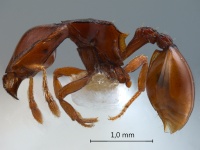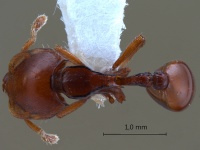Ishakidris
| Ishakidris | |
|---|---|

| |
| Ishakidris ascitaspis | |
| Scientific classification | |
| Kingdom: | Animalia |
| Phylum: | Arthropoda |
| Class: | Insecta |
| Order: | Hymenoptera |
| Family: | Formicidae |
| Subfamily: | Myrmicinae |
| Tribe: | Attini |
| Genus: | Ishakidris Bolton, 1984 |
| Type species | |
| Ishakidris ascitaspis | |
| Diversity | |
| 1 species (Species Checklist, Species by Country) | |
This monotypic genus is known from a single worker. The specimen was collected from a rainforest litter sample.
| At a Glance | • Monotypic |
Identification
Bolton (1984, 2003) - Diagnostic characters which in combination isolate Ishakidris from the workers of all other myrmicine ant genera are as follows.
1. Form and dentition of the massive mandibles
2. Palp formula 3,2.
3. Labrum anteriorly with a pair of elongate digitate lobes.
4. Antennae with 9 segments, the two apical segments forming a strongly defined club.
5. Antennal scrobes deep and extensive, the eye situated ventrolaterally within the scrobal area.
6. Head shield-like, the frontal carinae very widely separated and greatly expanded anteriorly and laterally.
7. Frontal carinae flanking lateral portions of clypeus and forming the anterolateral corners of the head.
8. Mesopleural presumed glandular area present, with subtending open groove.
9. Petiole and postpetiole lacking spongiform or lamellate appendages.
10. Massive longitudinal basal carina present on first gastral sternite.
| See images of species within this genus |
Keys including this Genus
Distribution
Malaysia: Sarawak
Distribution and Richness based on AntMaps
Species by Region
Number of species within biogeographic regions, along with the total number of species for each region.
| Afrotropical Region | Australasian Region | Indo-Australian Region | Malagasy Region | Nearctic Region | Neotropical Region | Oriental Region | Palaearctic Region | |
|---|---|---|---|---|---|---|---|---|
| Species | 0 | 0 | 1 | 0 | 0 | 0 | 0 | 0 |
| Total Species | 2840 | 1735 | 3042 | 932 | 835 | 4378 | 1740 | 2862 |
Biology
Castes
Known only from the worker caste.
Worker Morphology
 Explore: Show all Worker Morphology data or Search these data. See also a list of all data tables or learn how data is managed.
Explore: Show all Worker Morphology data or Search these data. See also a list of all data tables or learn how data is managed.
- Antennal segment count: 9
- Antennal club: 2
- Palp formula: 3,2
- Total dental count: 10-12
- Spur formula: 0, 0
- Scrobes: present
- Caste: monomorphic
- Sting: present
Nomenclature
The following information is derived from Barry Bolton's Online Catalogue of the Ants of the World.
- ISHAKIDRIS [Myrmicinae: Phalacromyrmecini]
- Ishakidris Bolton, 1984: 374. Type-species: Ishakidris ascitaspis, by original designation.
Unless otherwise noted the text for the remainder of this section is reported from the publication that includes the original description.
Diagnosis of worker. Ants belonging to subfamily Myrmicinae. Mandibles massively constructed and in profile the convex apical (masticatory) margin almost at a right-angle to the long axis of the head. Mandibles serially dentate and opposable, with 12 teeth on each apical margin and with the teeth alternately larger and smaller from base to apex; basal series of teeth larger than apical series and the mandible lacking a basal lamella. Labrum narrowly long-bilobed anteromedially. Palp formula 2,2 (in situ count). Outline shape of head in the form of a shield in full-face view, the occipital corners acute and the margin between them concave except for a shallow median convexity which encloses a translucent area of cuticle. Sides of head shallowly convex and continuous with the frontal carinae, the latter massively expanded anteriorly and laterally, fused to the sides of the clypeus and completely obscuring the lateral parts of the head from full-face view; the expanded portions of the frontal carinae semitranslucent. Clypeus broad and broadly inserted between the antennal articulations, the median portion of the anterior free margin evenly convex and prominent. Sites of the antennal insertions showing through the expanded flanges of the frontal carinae in full-face view as a pair of blister-like areas close to the anterior margin of the head and abutting the lateral clypeal margins. Antennae with 9 segments, the apical club of 2 segments. Head in profile with deep antennal scrobes, the eyes small and situated posteriorly within the scrobal area close to the ventrolateral margin. Ventrolateral margin of head delimited by a sharp longitudinal carina on each side which runs from the ventral base of the mandibular insertion to the posterior cuticular lug or flange at the occipital corner. Ventral surface of head with a broadly convex median bulge or tumulus. Alitrunk fused, without sutures, the pronotum marginate anteriorly and the sides marginate throughout their length. In profile the propodeal dorsum sloping downwards posteriorly to the triangular laminate propodeal spines, which themselves are subtended by, and partially fused with, a broad infradental lamella on each side. Orifice of propodeal spiracle circular, situated close to the posterior margin adjacent to the narrowest point of the propodeal infradental lamellae. Mesopleuron excavated anterodorsally just posterior to the posteroventral corner of the pronotal laterotergite, the excavated area containing a semicircular patch of thin cuticle upon which (or embedded in which) are a series of radially arranged fine hairs or cuticular processes. From this presumably glandular organ a shallow open groove extends posteroventrally, ending in a slit-like impression at the margin of the mesopleuron. In dorsal view the pronotum much broader than the mesonotum and propodeum, the last two separated by a low but sharp transverse carina. Petiole curved-clavate in profile, with a long anterior peduncle and a long low node. Anterodorsal angle of node blunt but well developed, the dorsum of the node merging evenly with the shallowly sloping posterior face, without a developed posterodorsal angle. Petiolar spiracle small, situated at about the midlength of the peduncle. Ventral process of petiole a low laminar crest which runs the length of the segment. In ventral view the process seen to be double and narrowly V-shaped, with a laminar crest ventrolaterally on each side of the peduncle diverging posteriorly and meeting anteriorly close to the insertion. First gastral tergite without a transverse lamellate or spongiform crest basally, the petiole, postpetiole and gaster lacking spongiform appendages. First gastral sternite basally with a very conspicuous broad median flat-topped longitudinal crest which fits between the ventrolateral flanges of the petiole and the postpetiolar laterosternal lobes and restricts the degree of anterior flexion of the gaster.
References
- Baroni Urbani, C.; De Andrade, M. L. 1994. First description of fossil Dacetini ants with a critical analysis of the current classification of the tribe (Amber Collection Stuttgart: Hymenoptera, Formicidae. VI: Dacetini). Stuttg. Beitr. Naturkd. Ser. B ( (page 31, Ishakidris in Myrmicinae, Dacetini)
- Bolton, B. 1984. Diagnosis and relationships of the myrmicine ant genus Ishakidris gen. n. (Hymenoptera: Formicidae). Syst. Entomol. 9: 373-382. (page 374, 382, Ishakidris as genus; Ishakidris in Myrmicinae, Phalacromyrmex genus group)
- Bolton, B. 1994. Identification guide to the ant genera of the world. Cambridge, Mass.: Harvard University Press, 222 pp. (page 106, Ishakidris in Myrmicinae, Phalacromyrmecini)
- Bolton, B. 1995a. A taxonomic and zoogeographical census of the extant ant taxa (Hymenoptera: Formicidae). J. Nat. Hist. 2 29: 1037-1056 (page 1050, Ishakidris in Myrmicinae, Phalacromyrmecini)
- Bolton, B. 1995b. A new general catalogue of the ants of the world. Cambridge, Mass.: Harvard University Press, 504 pp. (page 219, Ishakidris in Myrmicinae, Phalacromyrmecini)
- Bolton, B. 1998a. Monophyly of the dacetonine tribe-group and its component tribes (Hymenoptera: Formicidae). Bull. Nat. Hist. Mus. Entomol. Ser. 67: 65-78 (page 67, Ishakidris in Myrmicinae, Phalacromyrmecini)
- Bolton, B. 2003. Synopsis and Classification of Formicidae. Mem. Am. Entomol. Inst. 71: 370pp (page 192, Ishakidris in Myrmicinae, Phalacromyrmecini)
- Cantone S. 2018. Winged Ants, The queen. Dichotomous key to genera of winged female ants in the World. The Wings of Ants: morphological and systematic relationships (self-published).
- Dlussky, G. M.; Fedoseeva, E. B. 1988. Origin and early stages of evolution in ants. Pp. 70-144 in: Ponomarenko, A. G. (ed.) Cretaceous biocenotic crisis and insect evolution. Moskva: Nauka, 232 pp. (page 80, Ishakidris in Myrmicinae, Phalacromyrmecini)

